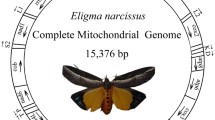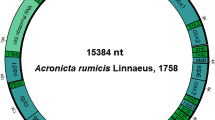Abstract
In this paper, the complete mitochondrial genome of Acraea issoria (Lepidoptera: Nymphalidae: Heliconiinae: Acraeini) is reported; a circular molecule of 15,245 bp in size. For A. issoria, genes are arranged in the same order and orientation as the complete sequenced mitochondrial genomes of the other lepidopteran species, except for the presence of an extra copy of tRNAIle(AUR)b in the control region. All protein-coding genes of A. issoria mitogenome start with a typical ATN codon and terminate in the common stop codon TAA, except that COI gene uses TTG as its initial codon and terminates in a single T residue. All tRNA genes possess the typical clover leaf secondary structure except for tRNASer(AGN), which has a simple loop with the absence of the DHU stem. The sequence, organization and other features including nucleotide composition and codon usage of this mitochondrial genome were also reported and compared with those of other sequenced lepidopterans mitochondrial genomes. There are some short microsatellite-like repeat regions (e.g., (TA)9, polyA and polyT) scattered in the control region, however, the conspicuous macro-repeats units commonly found in other insect species are absent.


Similar content being viewed by others
References
Wolstenholme DR (1992) Animal mitochondrial DNA: structure and evolution. Int Rev Cyt 141:173–216
Boore JL (1999) Animal mitochondrial genomes. Nucleic Acids Res 27:1767–1780
Taanman JW (1999) The mitochondrial genome: structure, transcription, translation and replication. Biochim Biophys Acta 1410:103–123
Pan MH, Yu QY, Xia YL, Dai FY, Liu YQ, Lu C, Zhang Z, Xiang ZH (2008) The organization of the Chinese Bombyx mandarina mitochondrial genome. Science 8:751–759
Ballard JWO, Whitlock MC (2004) The incomplete natural history of mitochondrial. Mol Ecol 13:729–744
Brown WM, George M, Wilson AC (1979) Rapid evolution of animal mitochondrial DNA. Proc Natl Acad Sci USA 76:1967–1971
Chou I (1998) Classification and Identification of Chinese butterflies. Henan Scientific and Technological Publishing House, Zhengzhou, pp 173–176
Penz CM, Peggie D (2003) Phylogenetic relationships among Heliconiinae genera based on morphology (Lepidoptera: Nymphalidae). Syst Entomol 28:451–479
Freitas AVL, Brown KS (2004) Phylogeny of the Nymphalidae (Lepidoptera). Syst Biol 53:363–383
Silva-Brandão KL, Wahlberg N, Francini RB, Azeredo-Espin AML, Brown KS Jr, Paluch M, Lees DC, Freitas AVL (2008) Phylogenetic relationships of butterflies of the tribe Acraeini (Lepidoptera, Nymphalidae, Heliconiinae) and the evolution of host plant use. Mol Phylogenet Evol 46:515–531
Simon C, Frati F, Bekenbach A, Crespi B, Liu H, Flook P (1994) Evolution, weighting, and phylogenetic utility of mitochondrial genesequences and a compilation of conserved polymerase chain-reaction primers. Ann Entomol Soc Am 87:651–701
Simons RB, Weller SJ (2001) Utility and evolution of cytochrome b in insects. Mol Phylogenet Evol 20:196–210
Caterino MS, Sperling FAH (1999) Papilio phylogeny based on mitochondrial cytochrome oxidase I and II genes. Mol Phylogenet Evol 11:122–137
Thompson JD, Gibson TJ, Plewniak F, Jeanmougin F, Higgins DG (1997) The clustal_X windows interface: flexible strategies for multiple sequence alignment aided by quality analysis tools. Nucleic Acids Res 25(24):4876–4882
Hall TA (1999) BioEdit: a user-friendly biological sequence alignment editor and analysis program for Windows 95/98/NT. Nucleic Acid Symp Ser 41:95–98
Lowe TM, Eddy SR (1997) tRNAscan-SE: a program for improved detection of transfer RNA genes in genomic sequence. Nucleic Acids Res 25:955–964
Kumar S, Tamura K, Nei M (2004) MEGA3: integrated software for molecular evolutionary genetics analysis and sequence alignment. Brief Bioinform 5:150–163
Kim I, Lee EM, Seol KY, Yun EY, Lee YB, Hwang JS, Jin BR (2006) The mitochondrial genome of the Korean hairstreak, Coreana raphaelis (Lepidoptera: Lycaenidae). Insect Mol Biol 15:217–225
Fenn JD, Cameron SL, Whiting MF (2007) The complete mitochondrial genome of the Mormon cricket (Anabrus simplex: Tettigoniidae: Orthoptera) and an analysis of control region variability. Insect Mol Biol 16:239–252
Cameron SL, Whiting MF (2007) Mitochondrial genomic comparisons of the subterranean termites from the Genus Reticulitermes (Insecta: Isoptera: Rhinotermitidae). Genome 50:188–202
Cameron SL, Johnson KP, Whiting MF (2007) The mitochondrial genome of the screamer louse Bothriometopus (Phthiraptera: Ischnocera): effects of extensive gene rearrangements on the evolution of the genome as a whole. J Mol Evol 65:589–604
Cameron SL, Dowton M, Castro LR, Ruberu K, Whiting MF, Austin AD, Diement K, Stevens J (2008) The sequence of the mitochondrial genomes of two vespid wasps reveals a number of derived tRNA gene rearrangements. Genome 51:800–808
Perna NT, Kocher TD (1995) Patterns of nueleotide composition at fourfold degenerate sites of animal mitochondrial genomes. J Mol Evol 41:353–358
Taylor MF, McKechnie SW, Pierce N, Kreitman M (1993) The lepidopteran mitochondrial control region: structure and evolution. Mol Biol Evol 10:1259–1272
Cameron SF, Whiting MF (2008) The complete mitochondrial genome of the tobacco hornworm, Manduca sexta (Insecta: Lepidoptera: Sphingidae), and an examination of mitochondrial gene variability within butterflies and moths. Gene 408:112–123
Lee ES, Shin KS, Kim MS, Park H, Cho S, Kim CB (2006) The mitochondrial genome of the smaller tea tortix Adoxophyes honmai (Lepidoptera: Tortricidae). Gene 373:52–57
Clary DO, Wolstenholme DR (1983) Genes for cytochrome c oxidase subunit I, URF2 and three tRNAs in Drosophila mitochondrial DNA. Nucleic Acids Res 11:6859–6872
De Bruijn MHL (1983) Drosophila melanogaster mitochondrial DNA, a novel organization and genetic code. Nature 304:234–241
Coates BS, Sumerford DV, Hellmich RL, Lewis LC (2005) Partial mitochondrial genome sequences of Ostrinia nubilalis and Ostrinia furnicalis. Int J Biol Sci 1:13–18
Wilson K, Cahill V, Ballment E, Benzie J (2000) The complete sequence of the mitochondrial genome of the crustacean Penaeus monodon: are Malacostracan crustaceans more closely related to insects than to Branchiopods. Mol Biol Evol 17(6):863–874
Beard CD, Hamm SM, Colllins FH (1993) The mitochondrial genome of the mosquito Anopheles gambiae: DNA sequence, genome organization, and comparisons with the mitochondrial sequences of other insect. Insect Mol Biol 2:103–124
Mitchell SE, Cockburn AF, Seawright JA (1993) The mitochondrial genome of Anopheles quadrimaculatus species A: complete nucleotide sequence and gene organization. Genome 36:1058–1073
Spanos L, Koutroumbras G, Kotsyfakis M, Louis C (2000) The mitochondrial genome of the Mediteranian fruit fly, Ceratitis capitata. Insect Mol Biol 9(2):139–144
Bae JS, Kim I, Sohn HD, Jin BR (2004) The mitochondrial genome of the firefly, Pyrocoelia rufa: complete DNA sequence, genome organization, and phylogenetic analysis with other insects. Mol Phylogenet Evol 32:978–985
Hong MY, Lee EM, Jo YH, Park HC, Kim SR, Hwang JS, Jin BR, Kang PD, Kim K, Han YS, Kim I (2008) Complete nucleotide sequence and organization of the mitogenome of the silk moth Caligula boisduvalii (Lepidoptera: Saturniidae) and comparison with other lepidopteran insects. Gene 413:49–57
Ojala D, Montoya J, Attardi G (1981) tRNA punctuation model of RNA processing in human mitochondria. Nature 290:470–474
Yukuhiro K, Sezutsu H, Itoh M, Shimizu K, Banno Y (2002) Significant levels of sequence divergence and gene rearrangements have occurred between the mitochondrial genomes of the wild mulberry silk moth, Bombyx mandarina, and its close relative, the domesticated silk moth, Bombyx mori. Mol Biol Evol 19:1385–1389
Lavrov DV, Brown WM, Boore JL (2000) A novel type of RNA editing occurs in the mitochondrial tRNAs of the centipede Lithobius forficatus. Proc Natl Acad Sci USA 97:13738–13742
Junqueira ACM, Lessinger AC, Torres TT, da Silva FR, Vettore AL, Arruda P, Espin AMLA (2004) The mitochondrial genome of the blowfly Chrysomya chloropyga (Diptera: Calliphoridae). Gene 339:7–15
Lessinger AC, Azeredo-Espin AML (2000) Evolution and structural organisation of mitochondrial DNA control region of myiasis-causing flies. Med Vet Entomol 14:71–80
Clayton DA (1992) Transcription and replication of animal mitochondrial DNA. Int Rev Cyt 141:217–232
Acknowledgments
This work was supported by the Scientific and Technologic Funds for the Outstanding Youth in Anhui Province (Grant No. 08040106811), the special funds for the outstanding college scholars and the “Key Laboratory of the Conservation and Utilization of Important Biological Resources” in Anhui Province, and partially by Supported by a grant (No. O529YX5105) from the Key Laboratory of the Zoological Systematics and Evolution of the Chinese Academy of Sciences, Public Welfare Project from the Ministry of Agriculture, China (Grant No. 200803006). We also thank Dr. Gai Yonghua (Nanjing Institute of Geology and Paleontology, Chinese Academy of Sciences), Liu Gang (College of Life Sciences, Anhui Normal University), Yu Fang, Yuan Feng, Chen FuQiang and Wang Chen (Institute of Zoology, Chinese Academy of Sciences) for their comments on the manuscript and kindly help in sequence analysis.
Author information
Authors and Affiliations
Corresponding authors
Electronic supplementary material
Below are the link to the electronic supplementary materials for Fig. 3 and Table 4.
Rights and permissions
About this article
Cite this article
Hu, J., Zhang, D., Hao, J. et al. The complete mitochondrial genome of the yellow coaster, Acraea issoria (Lepidoptera: Nymphalidae: Heliconiinae: Acraeini): sequence, gene organization and a unique tRNA translocation event. Mol Biol Rep 37, 3431–3438 (2010). https://doi.org/10.1007/s11033-009-9934-3
Received:
Accepted:
Published:
Issue Date:
DOI: https://doi.org/10.1007/s11033-009-9934-3




